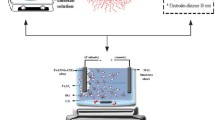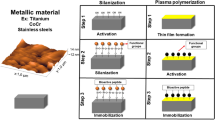Abstract
A solution is proposed to surpass the inconvenience caused by the corrosion of stainless steel implants in human body fluids by protection with thin films of bioactive glasses or with composite polymer-bioactive glass nanostructures. Our option was to apply thin film deposition by matrix-assisted pulsed laser evaporation (MAPLE) which, to the difference to other laser or plasma techniques insures the protection of a more delicate material (a polymer in our case) against degradation or irreversible damage. The coatings composition, modification and corrosion resistance were investigated by FTIR and electrochemical techniques, under conditions which simulate their biological interaction with the human body. Mechanical testing demonstrates the adhesion, durability and resistance to fracture of the coatings. The coatings biocompatibility was assessed by in vitro studies and by flow cytometry. Our results support the unrestricted usage of coated stainless steel as a cheap alternative for human implants manufacture. They will be more accessible for lower prices in comparison with the majority present day fabrication of implants using Ti or Ti alloys.







Similar content being viewed by others
References
Marciniak J. Perspectives of employing of the metallic biomaterials in the reconstruction surgery. Eng Biomater. 1997;1:12–20.
Zhou YL, Niinomi M, Akahori T, Fukui H, Toda H. Corrosion resistance and biocompatibility of Ti–Ta alloys for biomedical applications. Mater Sci Eng A. 2005;398:28–36.
Huang HH, Sun YS, Wu CP, Liu CF, Liaw PK, Kai W. Corrosion resistance and biocompatibility of Ni-free Zr-based bulk metallic glass for biomedical applications. Intermetallics. 2012;30:139–43.
Textor M, Sitting C, Frauchiger V, Tosatti S. Titanium in medicine: material science, surface science, engineering biological responses and medical applications. Berlin: Springer; 2001. p. 171.
Sansone V, Pagani D, Melato M. The effects on bone cells of metal ions released from orthopaedic implants. A review. Clin Cases Miner Bone Metab. 2013;10(1):34–40.
Blackwood DJ, Chua AWC, Seah KHW, Thampuran R, Teoh SH. Corrosion behaviour of porous titanium–graphite composites designed for surgical implants. Corros Sci. 2000;42(3):481–503.
Yaya K, Khelfaoui Y, Malki B, Kerkar M. Numerical simulations study of the localized corrosion resistance of AISI 316L stainless steel and pure titanium in a simulated body fluid environment. Corros Sci. 2011;53(10):3309–14.
Alves VA, Reis RQ, Santos ICB, Souza DG, de Gonçalves TF, Pereira-da-Silva MA, Rossi A, da Silva LA. In situ impedance spectroscopy study of the electrochemical corrosion of Ti and Ti–6Al–4V in simulated body fluid at 25°C and 37°C. Corros Sci. 2009;51(10):2473–82.
Oliveira NTC, Guastaldi AC. Electrochemical behavior of Ti–Mo alloys applied as biomaterial. Corros Sci. 2008;50(4):938–45.
Cvijović-Alagić I, Cvijović Z, Mitrović S, Panić V, Rakin M. Wear and corrosion behaviour of Ti–13Nb–13Zr and Ti–6Al–4V alloys in simulated physiological solution. Corros Sci. 2011;53(2):796–808.
Vasilescu C, Drob SI, Neacsu EI, Mirza Rosca JC. Surface analysis and corrosion resistance of a new titanium base alloy in simulated body fluids. Corros Sci. 2012;65:431–40.
Kierzkowska A, Malinowski M, Krasicka-Cydzik E. Characteristics of anodic layer on Ti6Al4V ELI alloy after bending. Mater Process Technol. 2007;1:320–34.
Vidal CV, Muñoz AI. Electrochemical characterisation of biomedical alloys for surgical implants in simulated body fluids. Corros Sci. 2008;50(7):1954–61.
Burstein GT, Liu C. Nucleation of corrosion pits in Ringer’s solution containing bovine serum. Corros Sci. 2007;49(11):4296–306.
Shahryari A, Szpunar JA, Omanovic S. The influence of crystallographic orientation distribution on 316LVM stainless steel pitting behavior. Corros Sci. 2009;51(3):677–82.
Shaikh H, Sivaibharasi N, Sasi B, Anita T, Amirthalingam R, Rao BPC, Jayakumar T, Khatak HS. Use of eddy current testing method in detection and evaluation of sensitisation and intergranular corrosion in austenitic stainless steels. Corros Scie. 2006;48(6):1462–82.
Rondelli G, Torricelli P, Fini M, Giardino R. In vitro corrosion study by EIS of a nickel-free stainless steel for orthopaedic applications. Biomaterials. 2005;26(7):739–44.
Cieślik M, Reczyński W, Janus AM, Engvall K, Socha RP, Kotarba A. Metal release and formation of surface precipitate at stainless steel grade 316 and Hanks solution interface—inflammatory response and surface finishing effects. Corros Sci. 2009;51(5):1157–62.
Okazakia Y, Gotoh E. Metal release from stainless steel, Co–Cr–Mo–Ni–Fe and Ni–Ti alloys in vascular implants. Corros Sci. 2008;50(12):3429–38.
Tanaskovic D, Jokic B, Socol G, Popescu A, Mihailescu IN, Petrovic R, Janackovic D. Synthesis of functionally graded bioactive glass—apatite multistructures on Ti substrates by pulsed laser deposition. Appl Surf Sci. 2007;254:1279–82.
Gyorgy E, Grigorescu S, Socol G, Mihailescu IN, Figueras A, Janackovic D, Palcevskis E, Zdrentu LE, Petrescu S. Bioactive glass and hydroxyapatite thin films obtained by pulsed laser deposition. Appl Surf Sci. 2007;253:7981–6.
Chrisey DB, Pique A, McGill RA, Horwitz JS, Ringeisen BR, Bubb DM, Wu PK. Laser deposition of polymer and biomaterial films. Chem Rev. 2003;103(2):553–76.
Mihailescu IN, Ristoscu C, Bigi A, Mayer I. Advanced biomimetic implants based on nanostructured coatings synthesized by pulsed laser technologies. In: Miotello A, Ossi P, editors. Laser-surface interactions for new materials production tailoring structure and properties. New York: Springer; 2010. p. 235–60.
Cristescu R, Stamatin I, Mihaescu DE, Ghica C, Albulescu M, Mihailescu IN, Chrisey DB. Pulsed laser deposition of biocompatible polymers: a comparative study in case of pullulan. Thin Solid Films. 2004;453(454):262–8.
Cristescu R, Mihaescu DE, Socol G, Stamatin I, Mihailescu IN, Chrisey DB. Deposition of biopolymer thin films by matrix assisted pulsed laser evaporation. J Appl Phys A. 2004;79:1023–6.
Pique A. Deposition of polymers and biomaterials using the matrix assisted pulsed laser evaporation (MAPLE) process. In: Eason R, editor. Pulsed laser deposition of thin films: applications—led growth of functional materials. New York: Wiley; 2008. p. 63–84.
Sima F, Ristoscu C, Popescu A, Mihailescu IN, Kononenko T, Simon S, Radu T, Ponta O, Mustata R, Sima LE, Petrescu SM. Bioglass-polymer thin coatings obtained by MAPLE for a new generation of implants. J Optoelectron Adv Mater. 2009;11(9):1170–4.
Kokubo T, Kushitani H, Sakka S, Kitsugi T, Yamamuro T. Solutions able to reproduce in vivo surface-structure changes in bioactive glass-ceramic A-W3J. Biomed Mater Res A. 1990;24(6):721.
http://www.bioeng.nus.edu.sg/people/PI/trau/Lab_manuals/Autolab%20manuals/Fra%20manual%204.9.pdf.
Grumezescu AM, Holban AM, Andronescu E, Mogosanu GD, Vasile BS, Chifiriuc MC, Lazar V, Andrei E, Constantinescu A, Maniu H. Anionic polymers and 10 nm Fe3O4@UA wound dressings support human foetal stem cells normal development and exhibit great antimicrobial properties. Int J Pharm. 2014;463(2):146–54.
Hench LL, Jones JR, Sepulveda P. Bioactive materials for tissue engineering scaffolds. In: Polak JM, Hench LL, Kemp P, editors. future strategies for tissue and organ replacement. London: Imperial College Press; 2002. p. 3–24.
Montel G, Bonel G, Heughebaert JC, Trombe JC, Rey C. New concepts in the composition, crystallization and growth of the mineral component of calcified tissue. J Cryst Growth. 1981;53(1):74–99.
Aziz-Kerrzo M, Conroy KG, Fenelon AM, Farrell ST, Breslin CB. Electrochemical studies on the stability and corrosion resistance of titanium-based implant materials. Biomaterials. 2001;22(12):1531–9.
Hodgson AWE, Mueller Y, Forster D, Virtanen S. Electrochemical characterization of passive films on Ti alloys under simulated biological conditions. Electrochim Acta. 2002;47(12):1913–23.
Marino CEB, Mascaro LH. EIS characterization of a Ti-dental implant in artificial saliva media: dissolution process of the oxide barrier. J Electroanal Chem. 2004;568:115–20.
Cai Z, Shafer T, Watanabe I, Nunn ME, Okabe T. Electrochemical characterization of cast titanium alloys. Biomaterials. 2003;24(2):213–8.
Pazo A, Saiz E, Tomsia AP. Silicate glass coatings on Ti-based implants. Acta Mater. 1998;46(7):2551–8.
Oliver WC, Pharr GM. An improved technique for determining hardness and elastic modulus using load and displacement sensing indentation experiments. J Mater Res. 1992;47:1564–83.
Hench LL. Bioceramics: from concept to clinic. J Am Ceram Soc. 1991;74(7):1487–510.
Maruyama N. Mechanical testing of metallic biomaterials. In: Niinomi M, editor. Metals for Biomedical Devices., Woodhead Publishing Series in BiomaterialsAmsterdam: Elsevier; 2010.
Acknowledgments
CR, FS, IN and INM acknowledge with thanks the financial support by UEFISCDI under the contracts ID 304/2011, and PCCA 244/2014. This work is also supported by the Sectorial Operational Programme Human Resources Development (SOP HRD), financed from the European Social Fund and by the Romanian Government under the Project Number POSDRU/159/1.5/S/134378.
Author information
Authors and Affiliations
Corresponding author
Rights and permissions
About this article
Cite this article
Floroian, L., Samoila, C., Badea, M. et al. Stainless steel surface biofunctionalization with PMMA-bioglass coatings: compositional, electrochemical corrosion studies and microbiological assay. J Mater Sci: Mater Med 26, 195 (2015). https://doi.org/10.1007/s10856-015-5527-y
Received:
Accepted:
Published:
DOI: https://doi.org/10.1007/s10856-015-5527-y




